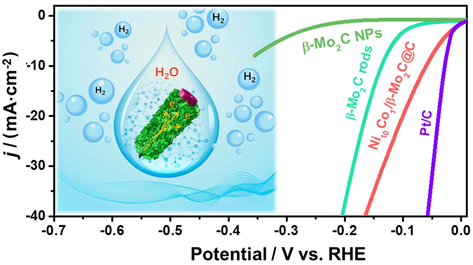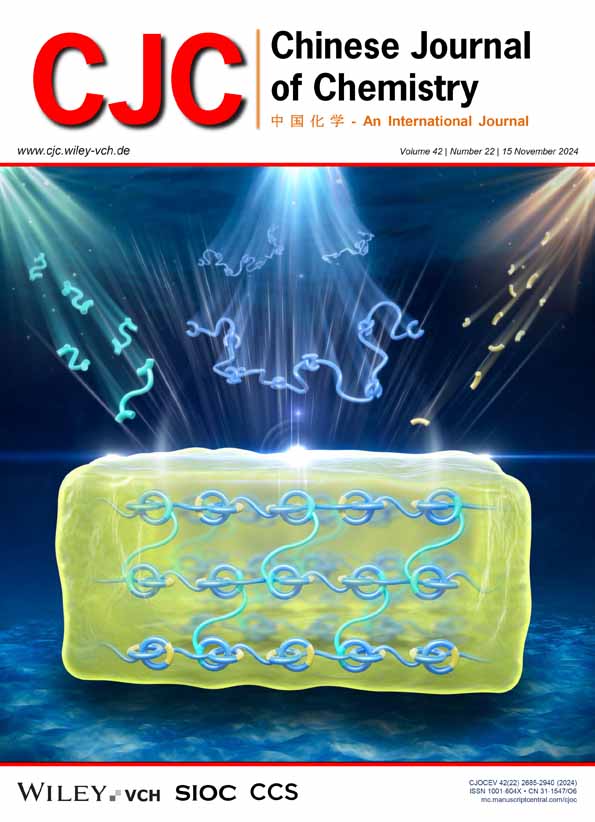Assembling 2D Ni-Co nanosheets onto Mo2C Nanorod towards Efficient Electrocatalytic Hydrogen Evolution†
Xiao Zhang
State Key Laboratory of Fine Chemicals, School of Chemistry, Dalian University of Technology, Dalian, Liaoning, 116024 China
Search for more papers by this authorYanan Diao
State Key Laboratory of Fine Chemicals, School of Chemistry, Dalian University of Technology, Dalian, Liaoning, 116024 China
Search for more papers by this authorHuizhu Cai
State Key Laboratory of Fine Chemicals, School of Chemistry, Dalian University of Technology, Dalian, Liaoning, 116024 China
Search for more papers by this authorJiancong Fang
State Key Laboratory of Fine Chemicals, School of Chemistry, Dalian University of Technology, Dalian, Liaoning, 116024 China
Search for more papers by this authorBingbing Chen
State Key Laboratory of Fine Chemicals, School of Chemistry, Dalian University of Technology, Dalian, Liaoning, 116024 China
Search for more papers by this authorMingshu Bi
State Key Laboratory of Fine Chemicals, School of Chemical Engineering, Dalian University of Technology, Dalian, Liaoning, 116024 China
Search for more papers by this authorCorresponding Author
Chuan Shi
State Key Laboratory of Fine Chemicals, School of Chemistry, Dalian University of Technology, Dalian, Liaoning, 116024 China
E-mail: [email protected]Search for more papers by this authorXiao Zhang
State Key Laboratory of Fine Chemicals, School of Chemistry, Dalian University of Technology, Dalian, Liaoning, 116024 China
Search for more papers by this authorYanan Diao
State Key Laboratory of Fine Chemicals, School of Chemistry, Dalian University of Technology, Dalian, Liaoning, 116024 China
Search for more papers by this authorHuizhu Cai
State Key Laboratory of Fine Chemicals, School of Chemistry, Dalian University of Technology, Dalian, Liaoning, 116024 China
Search for more papers by this authorJiancong Fang
State Key Laboratory of Fine Chemicals, School of Chemistry, Dalian University of Technology, Dalian, Liaoning, 116024 China
Search for more papers by this authorBingbing Chen
State Key Laboratory of Fine Chemicals, School of Chemistry, Dalian University of Technology, Dalian, Liaoning, 116024 China
Search for more papers by this authorMingshu Bi
State Key Laboratory of Fine Chemicals, School of Chemical Engineering, Dalian University of Technology, Dalian, Liaoning, 116024 China
Search for more papers by this authorCorresponding Author
Chuan Shi
State Key Laboratory of Fine Chemicals, School of Chemistry, Dalian University of Technology, Dalian, Liaoning, 116024 China
E-mail: [email protected]Search for more papers by this author† Dedicated to the Special Issue of Emerging Investigators in 2024.
Comprehensive Summary
A novel electrocatalyst, Ni-Co/β-Mo2C@C, was rationally designed to enhance the efficiency of the hydrogen evolution reaction (HER) in this work. Assembled with two-dimensional Ni-Co nanosheets onto Mo2C nanorods coated with a thin carbon shell, the catalyst demonstrates remarkable performance, including low overpotential (η10 = 57 mV) and reduced Tafel slope (63 mV·dec–1) in 0.5 mol·L–1 H2SO4 electrolyte. This innovative design strategy provides abundant active sites and efficient electron/ion transport pathways, effectively shortening reactant diffusion distances and enhancing electrocatalytic activity. Additionally, the carbon shell coating protects the catalyst from etching and agglomeration, ensuring its durability. This work presents a promising approach for engineering highly efficient metal carbide-based HER catalysts through tailored composition and nanostructure design.

Supporting Information
| Filename | Description |
|---|---|
| cjoc202400456-sup-0001-supinfo.pdfPDF document, 1.2 MB |
Appendix S1: Supporting Information |
Please note: The publisher is not responsible for the content or functionality of any supporting information supplied by the authors. Any queries (other than missing content) should be directed to the corresponding author for the article.
References
- 1 Gao, Q.; Zhang, W.; Shi, Z.; Yang, L.; Tang, Y. Structural Design and Electronic Modulation of Transition-Metal-Carbide Electrocatalysts toward Efficient Hydrogen Evolution. Adv. Mater. 2019, 31, e1802880.
- 2 Tong, Y.; Zhang, Z.; Hou, Y.; Yan, L.; Chen, X.; Zhang, H.; Wang, X.; Li, Y. Recent progress of molybdenum carbide based electrocatalysts for electrocatalytic hydrogen evolution reaction. Nanoscale 2023, 15, 14717–14736.
- 3 Zhou, W.; Jia, J.; Lu, J.; Yang, L.; Hou, D.; li, G.; Chen, S. Recent Developments of Carbon-based Electrocatalysts for Hydrogen Evolution Reaction. Nano Energy 2016, 28, 29–43.
- 4 Zou, X.; Zhang, Y. Noble metal-free hydrogen evolution catalysts for water splitting. Chem. Soc. Rev. 2015, 44, 5148–8180.
- 5 Zhang, J.; Wang, T.; Liu, P.; Liao, Z.; Liu, S.; Zhuang, X.; Chen, M.; Zschech, E.; Feng, X. Efficient hydrogen production on MoNi4 electrocatalysts with fast water dissociation kinetics. Nat. Commun. 2017, 8, 15437.
- 6 Zhao, Y.; Kumar, P. V.; Tan, X.; Lu, X.; Zhu, X.; Jiang, J.; Pan, J.; Xi, S.; Yang, H. Y.; Ma, Z.; Wan, T.; Chu, D.; Jiang, W.; Smith, S. C.; Amal, R.; Han, Z.; Lu, X. Modulating Pt-O-Pt atomic clusters with isolated cobalt atoms for enhanced hydrogen evolution catalysis. Nat. Commun. 2022, 13, 2430.
- 7 Park, H.; Encinas, A.; Scheifers, J. P.; Zhang, Y.; Fokwa, B. P. T. Boron-Dependency of Molybdenum Boride Electrocatalysts for the Hydrogen Evolution Reaction. Angew. Chem. Int. Ed. 2017, 56, 5575–5578.
- 8 Zhang, X.; Lai, Z.; Ma, Q.; Zhang, H. Novel structured transition metal dichalcogenide nanosheets. Chem. Soc. Rev. 2018, 47, 3301–3338.
- 9 Deng, J.; Li, H.; Wang, S.; Ding, D.; Chen, M.; Liu, C.; Tian, Z.; Novoselov, K. S.; Ma, C.; Deng, D.; Bao, X. Multiscale structural and electronic control of molybdenum disulfide foam for highly efficient hydrogen production. Nat. Commun. 2017, 8, 14430.
- 10 Chen, W.-F.; Muckerman, J. T.; Fujita, E. Recent developments in transition metal carbides and nitrides as hydrogen evolution electrocatalysts. Chem. Commun. 2013, 49, 8896–8909.
- 11 Cao, B.; Veith, G. M.; Neuefeind, J. C.; Adzic, R. R.; Khalifah, P. G. Mixed close-packed cobalt molybdenum nitrides as non-noble metal electrocatalysts for the hydrogen evolution reaction. J. Am. Chem. Soc. 2013, 135, 19186–19192.
- 12 Li, S.; Liu, J.; Yin, Z.; Ren, P.; Lin, L.; Gong, Y.; Yang, C.; Zheng, X.-S.; Cao, R.; Yao, S.; Deng, Y.; Liu, X.; Gu, L.; Zhou, W.; Zhu, J.-F.; Wen, X.-D.; Xu, B.; Ma, D. Impact of Coordination Environment on Atomically Dispersed Pt Catalyst for Oxygen Reduction Reaction. ACS Catal. 2019, 10, 907–913.
- 13 Baek, D. S.; Jung, G. Y.; Seo, B.; Kim, J. C.; Lee, H.-W.; Shin, T. J.; Jeong, H. Y.; Kwak, S. K.; Joo, S. H. Ordered Mesoporous Metastable α-MoC1−x with Enhanced Water Dissociation Capability for Boosting Alkaline Hydrogen Evolution Activity. Adv. Funct. Mater. 2019, 29, 1901217.
- 14 Koizumi, R.; Ozden, S.; Samanta, A.; Alves, A. P. P.; Mishra, A.; Ye, G.; Silva, G. G.; Vajtai, R.; Singh, A. K.; Tiwary, C. S.; Ajayan, P. M. Origami-Inspired 3D Interconnected Molybdenum Carbide Nanoflakes. Adv. Mater. Interfaces 2018, 5, 1701113.
- 15 Chen, M.; Hu, L.; Xu, L.; Wei, J.; Wu, P.; Guan, G.; Wang, T.; Ma, Y. Synergistically Tuning Surface States of Hierarchical MoC by Pt-N Dual-Doping Engineering for Optimizing Hydrogen Evolution Activity. Small Methods 2023, 7, e2300308.
- 16 Wang, W.; Wu, Y.; Lin, Y.; Yao, J.; Wu, X.; Wu, C.; Zuo, X.; Yang, Q.; Ge, B.; Yang, L.; Li, G.; Chou, S.; Li, W.; Jiang, Y. Confining Zero-Valent Platinum Single Atoms in α-MoC1−x for pH-Universal Hydrogen Evolution Reaction. Adv. Funct. Mater. 2022, 32, 2108464.
- 17 Wu, H. B.; Xia, B. Y.; Yu, L.; Yu, X. Y.; Lou, X. W. Porous molybdenum carbide nano-octahedrons synthesized via confined carburization in metal-organic frameworks for efficient hydrogen production. Nat. Commun. 2015, 6, 6512.
- 18 Zhao, L.; Yuan, H.; Sun, D.; Jia, J.; Yu, J.; Zhang, X.; Liu, X.; Liu, H.; Zhou, W. Active facet regulation of highly aligned molybdenum carbide porous octahedrons via crystal engineering for hydrogen evolution reaction. Nano Energy 2020, 77, 105056.
- 19 Ma, F. X.; Wu, H. B.; Xia, B. Y.; Xu, C. Y.; Lou, X. W. Hierarchical beta-Mo2C Nanotubes Organized by Ultrathin Nanosheets as a Highly Efficient Electrocatalyst for Hydrogen Production. Angew. Chem. Int. Ed. 2015, 54, 15395–15399.
- 20 Wang, S.; Wang, J.; Zhu, M.; Bao, X.; Xiao, B.; Su, D.; Li, H.; Wang, Y. Molybdenum-Carbide-Modified Nitrogen-Doped Carbon Vesicle Encapsulating Nickel Nanoparticles: A Highly Efficient, Low-Cost Catalyst for Hydrogen Evolution Reaction. J. Am. Chem. Soc. 2015, 137, 15753–15759.
- 21Gómez–Marín, A. M.; Ticianelli, E. A. Effect of transition metals in the hydrogen evolution electrocatalytic activity of molybdenum carbide. Appl. Catal., B 2017, 209, 600–610.
- 22 Greeley, J.; Jaramillo, T. F.; Bonde, J.; Chorkendorff, I.; Nørskov, J. K. Computational high-throughput screening of electrocatalytic materials for hydrogen evolution. Nat. Mater. 2006, 5, 909–913.
- 23 Michalsky, R.; Zhang, Y.-J.; Peterson, A. A. Trends in the Hydrogen Evolution Activity of Metal Carbide Catalysts. ACS Catal. 2014, 4, 1274–1278.
- 24 Lin, H.; Liu, N.; Shi, Z.; Guo, Y.; Tang, Y.; Gao, Q. Cobalt-Doping in Molybdenum-Carbide Nanowires Toward Efficient Electrocatalytic Hydrogen Evolution. Adv. Funct. Mater. 2016, 26, 5590–5598.
- 25 Hu, Z.; Zhang, L.; Huang, J.; Feng, Z.; Xiong, Q.; Ye, Z.; Chen, Z.; Li, X.; Yu, Z. Self-supported nickel-doped molybdenum carbide nanoflower clusters on carbon fiber paper for an efficient hydrogen evolution reaction. Nanoscale 2021, 13, 8264–8274.
- 26 Tominaga, H.; Aoki, Y.; Nagai, M. Hydrogenation of CO on molybde–num and cobalt molybdenum carbides. Appl. Catal., A 2012, 423–424, 192–204.
- 27 Lin, L.; Yu, Q.; Peng, M.; Li, A.; Yao, S.; Tian, S.; Liu, X.; Li, A.; Jiang, Z.; Gao, R.; Han, X.; Li, Y.-w.; Wen, X.-d.; Zhou, W.; Ma, D. Atomically Dispersed Ni/α-MoC Catalyst for Hydrogen Production from Methanol/Water. J. Am. Chem. Soc. 2020, 143, 309–317.
- 28 Lin, L.; Liu, J.; Liu, X.; Gao, Z.; Rui, N.; Yao, S.; Zhang, F.; Wang, M.; Liu, C.; Han, L.; Yang, F.; Zhang, S.; Wen, X. D.; Senanayake, S. D.; Wu, Y.; Li, X.; Rodriguez, J. A.; Ma, D. Reversing sintering effect of Ni particles on gamma-Mo2N via strong metal support interaction. Nat. Commun. 2021, 12, 6978.
- 29 Jiang, J.; Liu, Q.; Zeng, C.; Ai, L. Cobalt/molybdenum carbide@N- doped carbon as bifunctional electrocatalysts for hydrogen and oxygen evolution reactions. J. Mater. Chem. A 2017, 5, 16929–16935.
- 30 Zhang, X.; Liu, Y.; Zhang, M.; Yu, T.; Chen, B.; Xu, Y.; Crocker, M.; Zhu, X.; Zhu, Y.; Wang, R.; Xiao, D.; Bi, M.; Ma, D.; Shi, C. Synergy between β-Mo2C Nanorods and Non-thermal Plasma for Selective CO2 Reduction to CO. Chem 2020, 6, 3312–3328.
- 31 Wan, C.; Regmi, Y. N.; Leonard, B. M. Multiple Phases of Molybdenum Carbide as Electrocatalysts for the Hydrogen Evolution Reaction. Angew. Chem. Int. Ed. 2014, 53, 6407–6410.
- 32 Liu, Y.; Yu, G.; Li, G.-D.; Sun, Y.; Asefa, T.; Chen, W.; Zou, X. Coupling Mo2C with Nitrogen-Rich Nanocarbon Leads to Efficient Hydrogen- Evolution Electrocatalytic Sites. Angew. Chem. Int. Ed. 2015, 54, 10752–10757.




